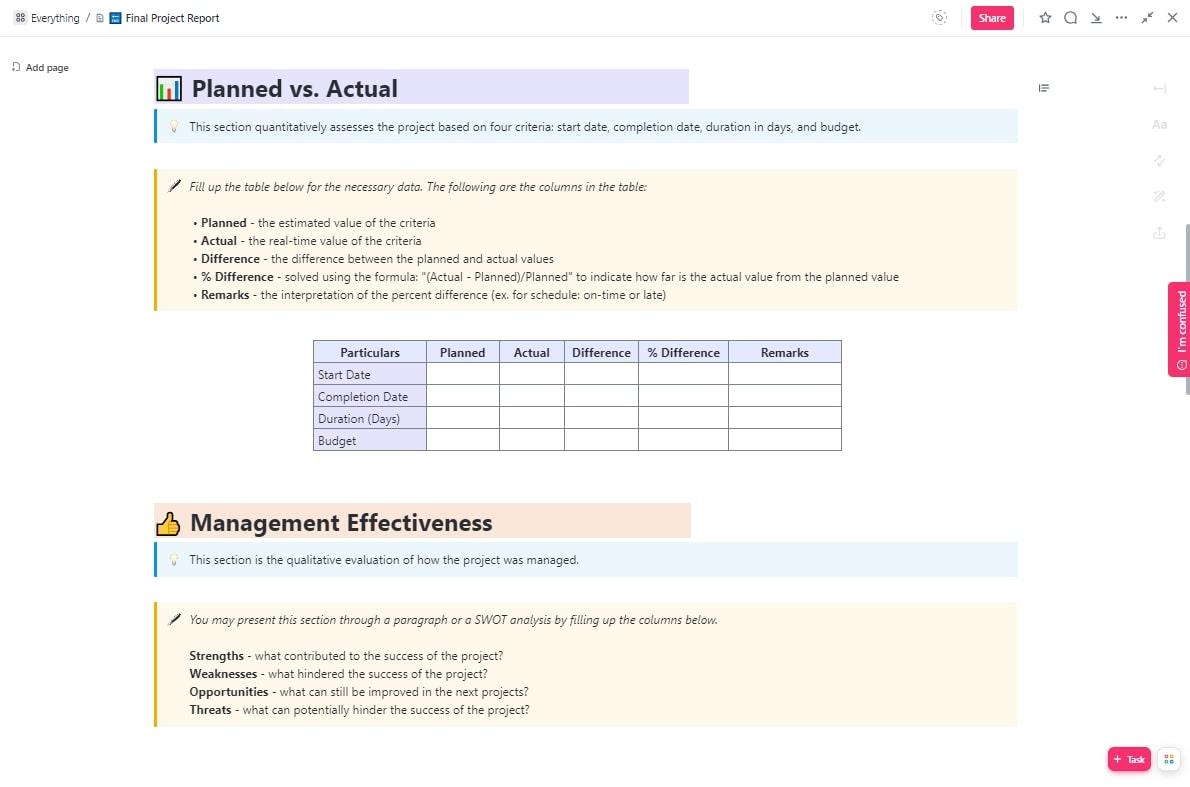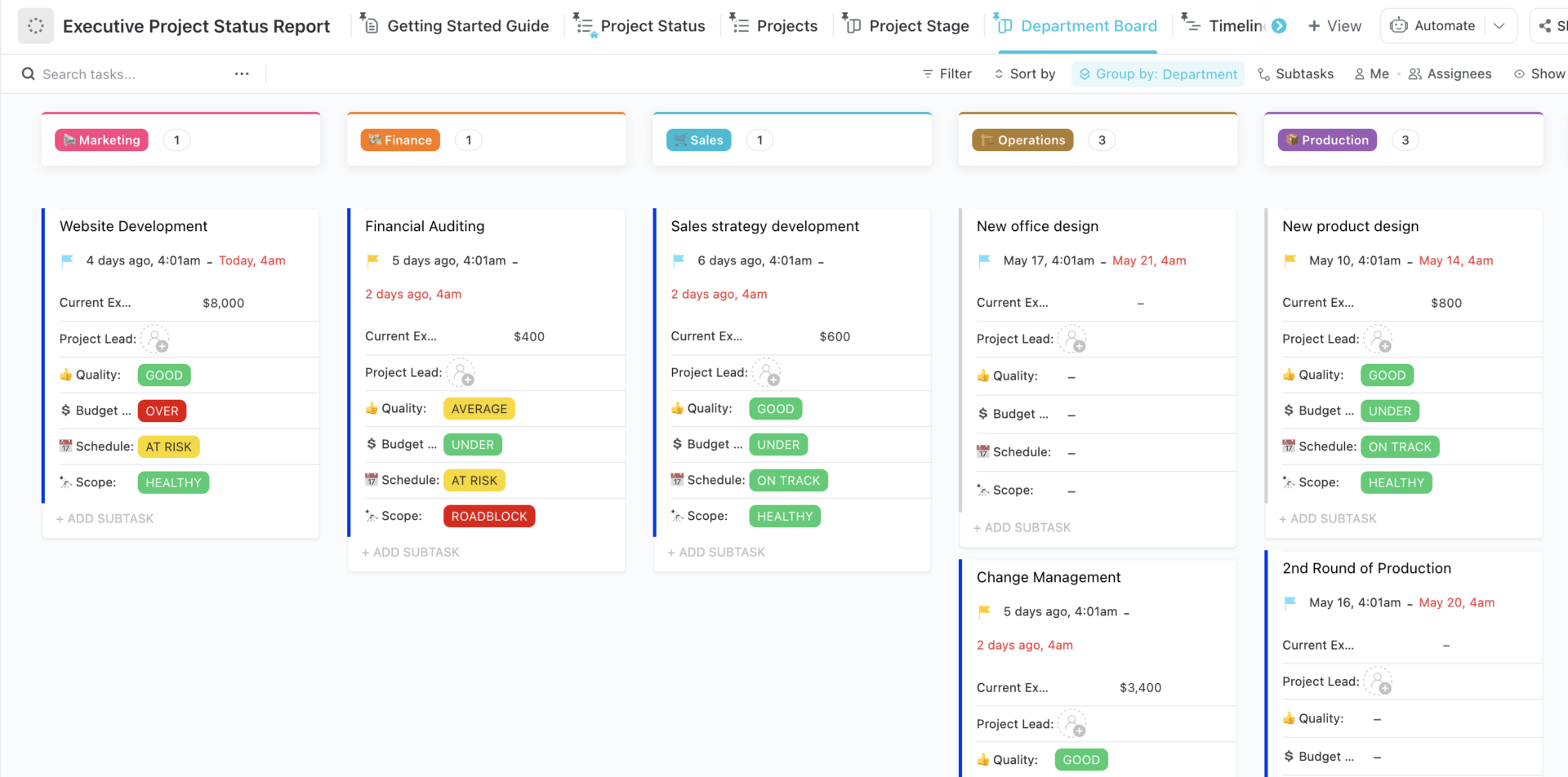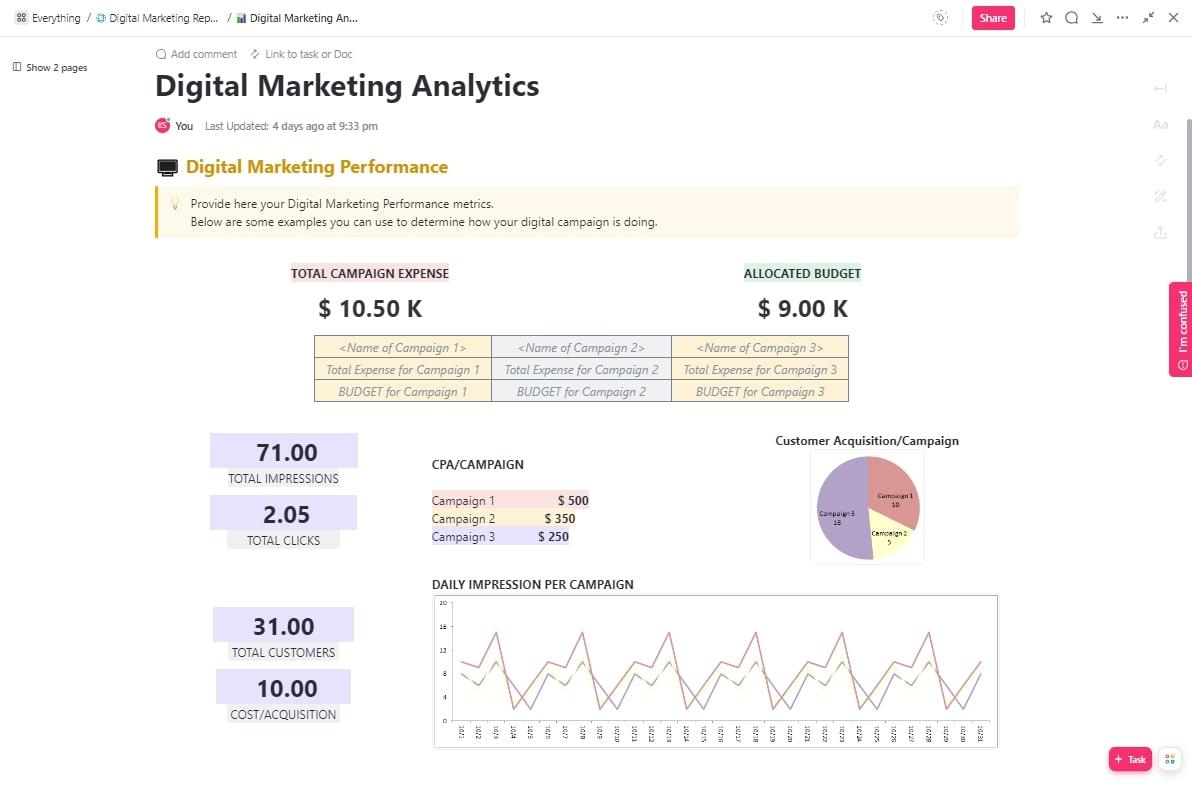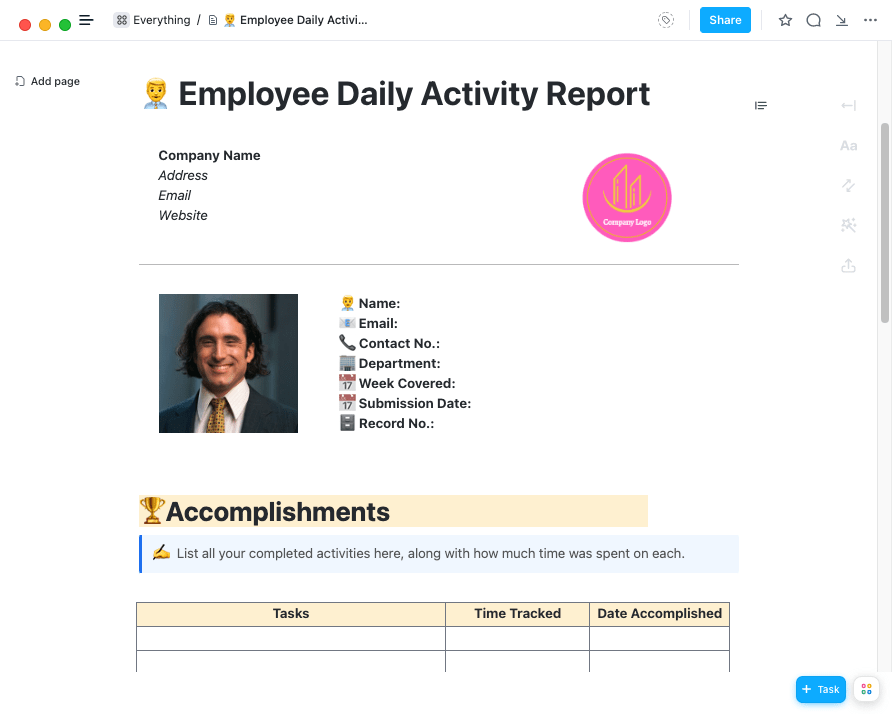يمكن أن يكون التوفيق بين جميع المكونات المختلفة للمشروع تحديًا كبيرًا. إذا لم يكن ذلك كافيًا، فعليك أيضًا كتابة تقرير حالة المشروع لإطلاع أصحاب المصلحة الرئيسيين على التقدم المحرز في المشروع. الصراع حقيقي.
إذن من أين تبدأ؟ لحسن الحظ، لدينا الإجابة. ولهذا السبب بالتحديد وضعنا هذا الدليل - لإرشادك خلال العملية حتى يكون لديك مسار واضح من البداية إلى النهاية.
تعرف على المزيد حول إنشاء تقارير المشروع والأنواع المختلفة لتقارير حالة المشروع. بالإضافة إلى ذلك، ستحصل على خمسة قوالب مجانية لتقارير المشاريع، تم تصميمها بعناية لتبسيط سير عمل إدارة المشروع الخاص بك، وتوفير الوقت، وإثارة إعجاب أصحاب المصلحة لديك. 🤩
ما هو تقرير المشروع؟
تقرير المشروع هو وثيقة تقدم لمحة شاملة عن أهداف المشروع والتقدم المحرز فيه وأداء الفريق والإنجازات البارزة. كما أنه يعطي سردًا للتحديات التي واجهت المشروع خلال تنفيذ المشروع والحلول المبتكرة لمعالجتها، والدروس المستفادة خلال العملية.
يقوم مديرو المشاريع بإعداد هذه التقارير للتواصل مع أصحاب المصلحة الآخرين في المشروع - بما في ذلك أعضاء الفريق والجهات الراعية والعملاء والأطراف المعنية الأخرى - لضمان أن الجميع على نفس الصفحة. تعمل الوثيقة أيضًا كأساس لمزيد من التقييم والتحليل لضمان سير المشروع على المسار الصحيح وتحقيق أهدافه. 🎯

كيفية كتابة تقرير المشروع؟
لا يجب أن يكون إنشاء تقرير مشروع مهمة شاقة. اتبع هذه الخطوات الثلاث البسيطة لإنشاء تقرير مشروعك الأول بكل سهولة.
افهم الغرض من التقرير
قبل أن تقوم بإنشاء تقرير مشروع، عليك أن تفهم الغرض من التقرير ("لماذا") وتعرف جمهورك المستهدف ("من"). سيوجه ذلك محتوى تقرير مشروعك وهيكله ونبرته.
اجمع المعلومات ذات الصلة ونظمها
في هذه المرحلة، تحتاج إلى جمع معلومات المشروع ذات الصلة بتقرير مشروعك. تأكد من أن بياناتك دقيقة وموثوقة ومحدثة. قم بتنظيم المعلومات التي تم جمعها بطريقة منطقية ومنظمة.
- ملخص تنفيذي : كما يوحي اسمه، هذاملخص المشروع يعطي القراء لمحة سريعة عن التقرير بأكمله. إنها لمحة سريعة تسلط الضوء على أهم أجزاء المشروع. وعلى الرغم من أنه يوضع في بداية التقرير، إلا أنه غالبًا ما يُكتب في آخره. وهي تغطي أهداف المشروع ومنهجيته ونتائجه الرئيسية واستنتاجاته.
- المقدمة: تحدد هذه المقدمة سياق التقرير بأكمله وتوقعاته. وهي تتضمن غرض المشروع ونطاقه، والجدول الزمني للمشروع، والمشاكل التي يهدف إلى معالجتها، والمنهجيات التي يجب اتباعها للوصول إلى ذلك. كما أنها تحدد هيكل وتنظيم بقية التقرير.
- المتن: عادةً ما يكون هذا هو الجزء الأطول في تقارير إدارة المشروع لأنه يغوص في التفاصيل المتعمقة، بما في ذلك التقدم المحرز في المشروع وجمع البيانات وتقارير التحليل والقيود والقيود. تذكر أن كل ما تدرجه هنا يجب أن يعكس الغرض من تقرير مشروعك وتفضيلات جمهورك المستهدف.
- الاستنتاجات والتوصيات: استنادًا إلى النتائج والتحليلات التي توصلت إليها، حدد فرص التحسين، واقترح استراتيجيات لمعالجتها، أو اقترح سبلًا للبحث المستقبلي.
تنسيق التقرير وتدقيقه
تأكد من أن تقرير مشروعك يتبع أسلوب تنسيق متسق - فالعناوين والعناوين الفرعية والنقاط النقطية ستسهل قراءته. بالإضافة إلى ذلك، افحص تقريرك بحثًا عن الأخطاء الإملائية والنحوية والأخطاء المطبعية.
أنواع تقارير المشاريع
تأتي تقارير المشاريع بتنسيقات متنوعة، حيث يخدم كل منها حالات استخدام مختلفة. فيما يلي تسعة من أكثر أنواع تقارير المشاريع استخدامًا.
1. تقرير حالة المشروع
A تقرير حالة المشروع هو مستند يعطي لمحة عن وضع مشروعك في أي لحظة. إنه يشبه الإجابة على السؤال "كيف يسير المشروع؟
ولكن بدلاً من مجرد قول "المشروع على ما يرام"، فإنك في الواقع تتعمق في أهداف المشروع والمهام المنجزة والمعالم التي تم تحقيقها والتحديات التي واجهتها والدروس المستفادة والعقبات المحتملة والخطوات التالية.

قم بإنشاء حالات مخصصة تناسب سير العمل الخاص بفريقك في ClickUp
سواءً كان تقرير حالة المشروع الأسبوعي أو تقرير الحالة الشهري، فإن هذا التوثيق يلغي الحاجة إلى اجتماعات الحالة مع إعطاء أصحاب المصلحة أحدث حالة للمشروع.
2. تقرير حالة المشروع
يشبه التقرير المرحلي للمشروع إلى حد ما تقرير تحديث الحالة، حيث يناقش كلاهما التقدم المحرز في المهام. ومع ذلك، فإن التقرير المرحلي يكون أكثر كمًا ويقتصر على المهام الفردية و معالم المشروع .

احصل على نظرة عامة عالية المستوى حول كيفية تقدم المبادرات المتوافقة مع أداة المحفظة في ClickUp
إنها مثل أخذ عدسة مكبرة وفحص التقدم المحرز في كل مهمة، واحدة تلو الأخرى. على سبيل المثال، يمكن أن تتضمن معلومات متعمقة حول النسبة المئوية للإنجاز والحالة الحالية لكل مهمة (مكتملة، في المسار الصحيح، متأخرة، إلخ).
3. تقرير تحليل تكلفة وفوائد المشروع
يمكن أن يتضمن تقرير تحليل التكلفة والعائد عادة ما يتم إعداده قبل بدء تنفيذ المشروع. من بين تقارير المشاريع المختلفة، يهدف هذا التقرير إلى الإجابة على سؤال بسيط: "هل يستحق متابعة هذا المشروع؟"
للإجابة على هذا السؤال، يقوم التقرير أولاً بتقييم جميع تكاليف المشروع مثل النفقات التشغيلية والمواد والرواتب والمعدات والمخاطر المحتملة.
ثم يأخذ التقرير في الاعتبار الفوائد المتوقعة، مثل زيادة هوامش الربح أو توفير التكاليف أو تحسين الكفاءة أو إسعاد العملاء. وأخيرًا، يقارن التقرير التكاليف بالفوائد لتحديد ما إذا كان الوقت قد حان للمضي قدمًا أو استكشاف خيارات أخرى.
4. تقرير تتبع وقت المشروع
تقرير تتبع وقت المشروع هو وثيقة تسجل وتلخص الوقت المستغرق في أنشطة المشروع. ويساهم كل عضو من أعضاء فريق المشروع في كتابة هذا التقرير - حيث يتتبعون ويسجلون مقدار الوقت الذي قضوه في المهام ويرفعونه إلى مدير المشروع. ⏰
![]()
سجل الوقت أثناء التنقل أو أدخله يدويًا باستخدام تتبع الوقت في ClickUp
لحسن الحظ، فإن ظهور أدوات إدارة المشاريع ألغت الحاجة إلى تقديم التقارير الورقية لتتبع الوقت. فهي تجعل من السهل على أعضاء الفريق تقديم تقارير دقيقة ومفصلة عن الوقت إلى مدير المشروع - مع تقليل العبء الإداري لتجميع التقارير يدويًا.
يمكن لمديري المشاريع معرفة كيفية قضاء الوقت والإنتاجية الإجمالية لأعضاء الفريق. ونتيجةً لذلك، يمكنهم اتخاذ قرارات مستنيرة، مثل إعادة توزيع عبء العمل (المعروف أيضًا باسم إدارة عبء العمل )، وإعادة إسناد المهام، وتقديم الملاحظات والدعم لأعضاء الفريق.
5. تقرير موارد المشروع
A لوحة معلومات موارد المشروع تقدم نظرة شاملة لكيفية تخصيص الموارد (مثل العمالة والمعدات والمواد والميزانية والميزانية وغيرها) في المشروع. فكر في الأمر على أنه جرد شامل للموارد، مع سرد كل مهمة من مهام المشروع والجهة المسؤولة والموارد المستخدمة.
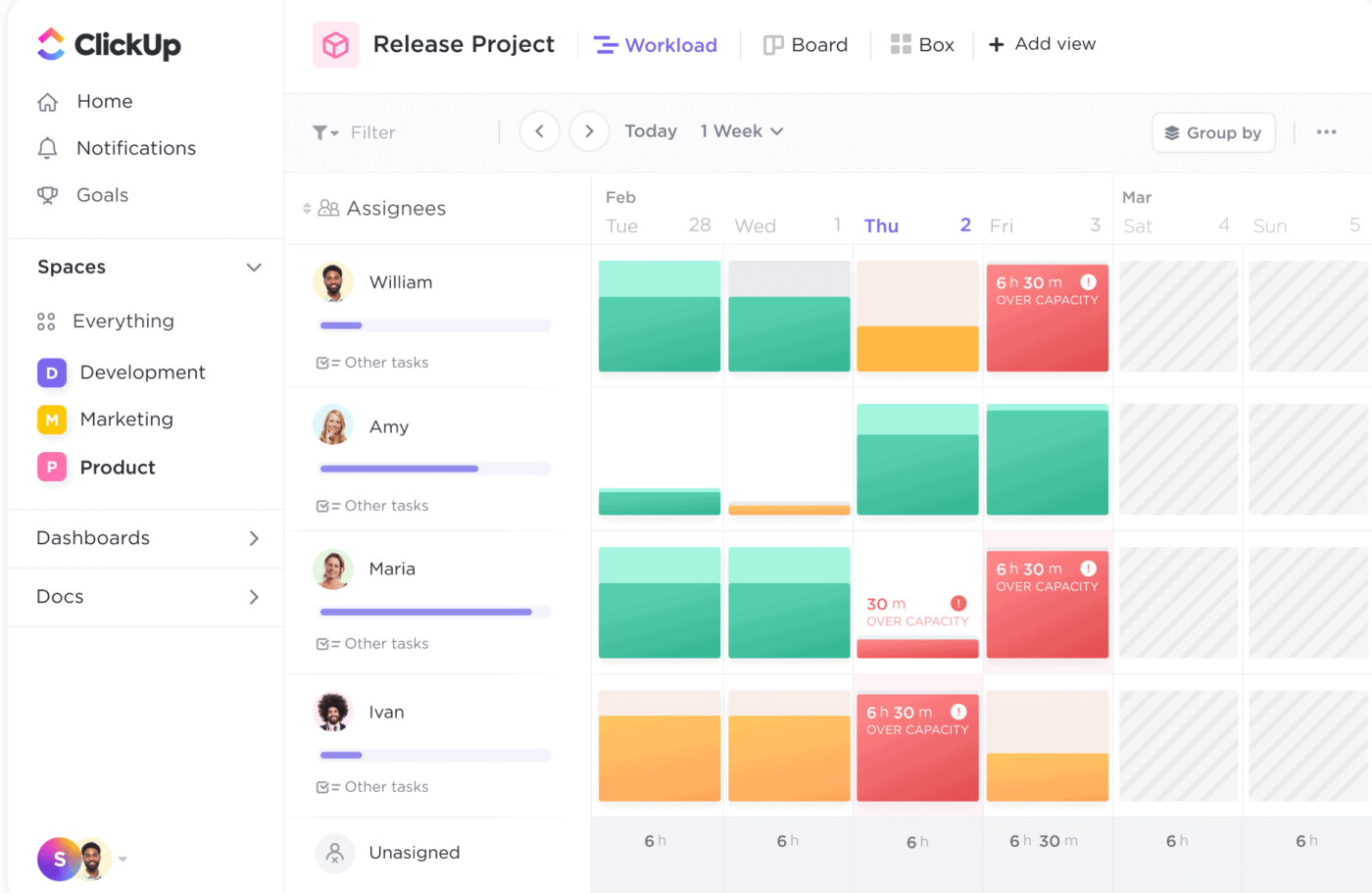
افهم في لمحة سريعة من في فريقك الذي يعاني من نقص أو إفراط في العمل حتى تتمكن من إعادة تخصيص مواردك بسهولة
تساعد تقارير المشاريع مثل هذه التقارير مديري المشاريع على تتبع مدى توفر الموارد، وتحديد قيود الموارد أو النقص، واتخاذ قرارات مستنيرة بشأن تخصيص الموارد والتحسين.
6. تقرير مخاطر المشروع
يقدم تقرير مخاطر المشروع تحليلاً شاملاً للمخاطر المحتملة واحتمالية حدوثها وتأثيرها المحتمل على المشروع واستراتيجيات التخفيف الموصى بها.
وبدلاً من انتظار الأحداث المستقبلية لإخراج المشروع عن مساره، تسمح تقارير المشروع مثل هذا التقرير لمديري المشروع باتخاذ نهج أكثر استباقية لإدارة المخاطر - وبالتالي تعزيز فرص نجاح المشروع بشكل عام.
7. تقرير التباين في المشروع
يكشف تقرير التباين في المشروع عن الثغرات أو الانحرافات بين خطط المشروع والأداء الفعلي أو النتائج المحققة. حيث يقارن بين العوامل المختلفة - مثل الميزانية والوقت والموارد والنطاق - وقيمها المخططة مع قيمها الفعلية، ثم يحسب الفروق (أو الفروق).
ومن خلال تحليل هذه الفروقات، يمكن لمديري المشروع وأصحاب المصلحة مناقشة الأسباب المحتملة وراءها، وتحديد المجالات التي تحتاج إلى اهتمام، واتخاذ إجراءات تصحيحية عند الضرورة.
8. تقرير أداء المشروع
يقيّم تقرير أداء المشروع الأداء العام للمشروع وإنجازاته مقارنةً بالمقاييس والأهداف المحددة مسبقًا. ويتضمن معلومات عن منجزات المشروع, مؤشرات الأداء الرئيسية (KPIs) ورضا أصحاب المصلحة.
يساعد هذا التقرير مديري المشاريع على تقييم نجاح المشروع، وتحديد مجالات التحسين، وتوصيل أداء المشروع إلى أصحاب المصلحة.
9. تقرير إنجاز المشروع
يمثل تقرير إنجاز المشروع نهاية رحلة المشروع. وهو يلخص دورة حياة المشروع بأكملها، بدءًا من البداية وحتى الإغلاق. يحتوي هذا التقرير على لمحة عامة عن أهداف المشروع ومنجزاته ومعالمه والتحديات والتوصيات الخاصة بالمشروعات المستقبلية.
ما أهمية إعداد تقارير المشروع؟
قد تبدو كتابة تقارير المشروع في البداية زائدة عن الحاجة ومستهلكة للوقت. ومع ذلك، فإنها تلعب دورًا حاسمًا في تحقيق نجاح المشروع. في حين تم التلميح إلى بعض الفوائد في وقت سابق، دعنا نتعرف بشكل أفضل على سبب عدم إغفال تقارير المشروع.
مزيد من الوضوح
يسمح لك إنشاء تقرير المشروع بالرجوع إلى الوراء والتفكير في تقدم المشروع. بينما تقوم بتسجيل المعالم والنجاحات والتحديات، تبدأ ثروة من الرؤى في الظهور - نقاط القوة والضعف والمجالات التي تحتاج إلى اهتمام.
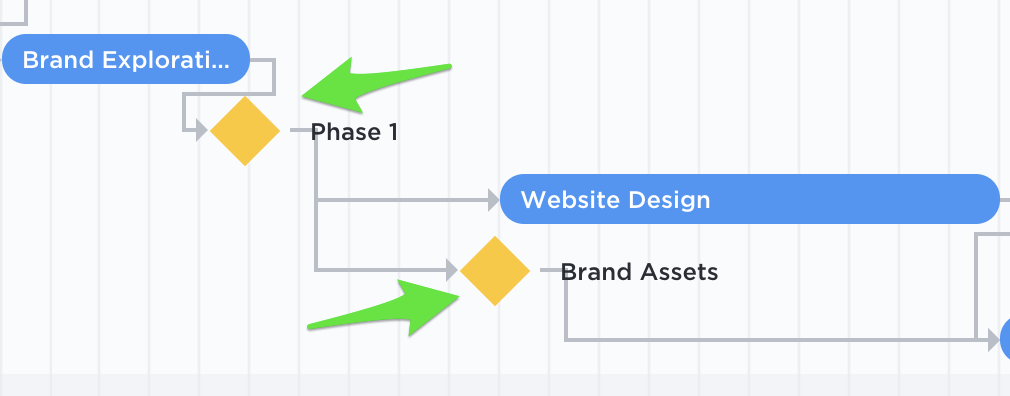
أمثلة على معالم المشروع في ClickUp
تساعدك هذه النظرة الشاملة لسلامة المشروع على توجيهه نحو النتائج المرجوة وضمان بقائه على المسار الصحيح.
يشجع على التقييم والتحليل
تتيح لك تقارير المشروع تقييم وتحليل الجوانب المختلفة للمشروع بطريقة منهجية - جمع البيانات ذات الصلة وتحليلها وتقييم أهميتها. من خلال إعطاء مشروعك تحليلاً نقديًا، يمكنك الكشف عن رؤى قيمة، وتحديد الأنماط، واستخلاص استنتاجات ذات مغزى، واتخاذ إجراءات استراتيجية. 🛠️
يعزز التواصل والتعاون
يتحداك إنشاء تقرير المشروع في تقديم تقدم المشروع ونتائجه إلى أصحاب المصلحة بطريقة واضحة ومتماسكة. تقرير مكتوب بشكل جيد يعزز شفافية المشروع ويضمن أن يكون الجميع على نفس الصفحة.

استخدم ClickUp Whiteboards لتعيين المهام، ووضع علامات على المعينين، وأي شيء مطلوب لبدء تعاونك التالي
كما أنها تسهّل التعاون من خلال توفير نقطة مرجعية مشتركة للمناقشات والتعليقات واتخاذ القرارات.
يعزز الاحترافية والمصداقية
عندما تقدم تقريرًا شاملاً ومنظمًا بشكل جيد، فإن ذلك يُظهر أنك أجريت بحثًا شاملاً واتبعت نهجًا منهجيًا ويمكنك توصيل المعلومات المعقدة بشكل فعال. وهذا بدوره يعزز من سمعتك ويعزز مصداقيتك ويبرز خبرتك بين أقرانك وزملائك وأصحاب العمل المحتملين.
حفظ المعرفة
يعمل تقرير المشروع كمرجع قيّم للأبحاث أو المشاريع المستقبلية. من خلال توثيق العملية والمنهجيات والتحديات والدروس والنتائج، فإنك تنشئ موردًا يمكن للآخرين الرجوع إليه والبناء عليه.
وهذا يساهم في المعرفة التراكمية في مجال عملك ويعزز ثقافة التعاون والابتكار.
يحسّن مواءمة الفريق
تقارير المشروع مفيدة في تعزيز مواءمة الفريق. فهي توفر لمحة واضحة وموجزة عن التقدم المحرز، وتحدد الإنجازات والتحديات والخطوات التالية. وهذا يمكّن جميع أعضاء الفريق من فهم الوضع الحالي للمشروع ودور كل منهم في تحقيق الأهداف العامة.
اطلع على نماذج تقارير المشروع هذه لفرق العمل:
- تقرير مشروع المنظمات غير الربحية
- تقرير مشروع فرق العمليات
- تقرير مشروع فرق التطوير والعمليات
- تقرير مشروع الفرق الرشيقة
- تقرير مشروع فرق المبيعات
5 أمثلة وقوالب تقارير المشاريع
بالتأكيد، يمكنك كتابة تقارير المشروع من الصفر وقضاء ساعات لا تحصى في تنسيقها وهيكلتها. ولكن لماذا تفعل ذلك بينما يمكنك استخدام قوالب تقارير المشاريع المجانية؟ فهي توفر هيكلاً وتنسيقاً لتقريرك بحيث يمكنك ببساطة إدخال بياناتك وتخصيص التصميم ليناسب احتياجاتك. لا يقتصر دور قوالب تقارير المشاريع على تسريع عملية إنشاء التقارير فحسب، بل إنها تعمل أيضًا على تحسين الجودة العامة لتقاريرك.
لننتقل مباشرةً لاستكشاف أفضل خمسة قوالب لتقارير المشاريع. 📈
1. قالب تقرير المشروع النهائي
قالب التقرير النهائي للمشروع
التقرير النهائي للمشروع هو اللمسة النهائية المثالية لاختتام المشروع وتسليط الضوء على إنجازاته. قالب تقرير المشروع النهائي من ClickUp يوفر هيكلًا متينًا لمساعدتك في وضعه مع الأقسام الرئيسية التالية:
- المخطط له مقابل الفعلي: تفصيل كمي لكيفية انحراف المشروع عن الخطة الأصلية فيما يتعلق بتاريخ البدء وتاريخ الانتهاء والمدة والميزانية
- فعالية الإدارة: أSWOT (نقاط القوة والضعف والفرص والتهديدات) تحليل يقيّم كيفية إدارة المشروع
- الدروس المستفادة من المشروع : مشاركة الدروس المهمة المستفادة من المشروع التي تعلمها الفريق طوال عمر المشروع
- قائمة مراجعة شروط العقد : جدول بسيط يسرد مختلف شروط العقد، وما إذا كانت قد اكتملت، وأي ملاحظات لديك
- تقييم الأداء العام: تقييم 1 من أصل 5 لجوانب المشروع المختلفة، من التخطيط والتنفيذ إلى القيادة والتواصل
هذا النموذج مدمج في مستندات ClickUp مما يعني أن لديك مرونة غير محدودة في التخصيص - أضف أقسامًا إضافية وعدّل المظهر بما يتناسب مع ذوقك. وخمن ماذا؟ يتم تحديث جدول المحتوى في الوقت الفعلي عند إضافة أو تعديل أو حذف رؤوس متعددة.
إذا كنت ترغب في إبهار فريقك وعملائك، فإن قالب تقرير حالة المشروع هذا سيساعدك على إنجاز المهمة. تنزيل هذا القالب
2. قالب تقرير حالة المشروع
قالب تقرير حالة المشروع
كتابة تقرير حالة المشروع أمر بسيط إلى حد ما. لكن التحديق في مستند فارغ والقلق بشأن صياغة جمل متقنة تمامًا يمكن أن يجعل هذه العملية تستغرق وقتًا أطول مما ينبغي.
لحسن الحظ, قالب تقرير حالة المشروع الخاص ب ClickUp هنا لإنقاذ الموقف! يوفر هذا القالب المدمج داخل ClickUp Whiteboards، طريقة خالية من المتاعب لالتقاط تفاصيل المشروع الرئيسية بسرعة بطريقة جذابة بصريًا.
- معلومات عامة: تغطية التفاصيل العامة للمشروع (مثل اسم المشروع وأهدافه,الجدول الزمني للمشروع، فترة إعداد التقرير، إلخ) والتي ستحتاج إلى ملئها مرة واحدة فقط
- تفاصيل التقدم: استخدم الترميز بالألوان لمشاركة المهام قيد التنفيذ، والمهام المعرضة للخطر، والمهام المتأخرة، والمهام المكتملة
- الدعم والموارد: ضع قائمة بالأصول (مثل العمالة والمال وغيرها) اللازمة لسلاسة العملية
- أبرز النقاط البارزة والدروس المستفادة: شارك الدروس الرئيسية المستفادة وغيرها من النقاط البارزة الجديرة بالملاحظة
- ما الذي سار بشكل جيد/ما الذي يحتاج إلى تحسين: اغتنم هذه الفرصة للتفكير في التقدم المحرز في المشروع ومشاركة المجالات التي كان أداؤها جيداً والمجالات التي تحتاج إلى اهتمام
- الخطوات التالية: تسليط الضوء على النقاط الرئيسيةعناصر العمل التي يجب إنجازها لإبقاء المشروع على المسار الصحيح
قم بإدخال التفاصيل تحت كل قسم من هذه الأقسام على الملاحظات اللاصقة، مما سيساعدك على سكب أفكارك بسرعة دون القلق بشأن كتابة جمل مثالية. كما أنها مفيدة جدًا لأصحاب المصلحة حيث أن المعلومات على الملاحظات اللاصقة قصيرة ومباشرة في صلب الموضوع.
يزيل هذا القالب ضغط إنشاء تقرير الحالة ويوفر وقتًا ثمينًا - كل ذلك مع إبقاء أصحاب المصلحة الرئيسيين على اطلاع دائم ومحدث. تنزيل هذا القالب
3. قالب تقرير التسويق الرقمي
قالب تقرير التسويق الرقمي
بعد تشغيل مشروع حملة تسويق رقمي، تحتاج إلى جمع المقاييس الرئيسية من الحملة وتقديمها إلى أصحاب المصلحة الرئيسيين لتقييمها وتحليل الأداء وإبداء الملاحظات للتحسينات المستقبلية.
قد تكون مشاركة هذه المعلومات عبر قنوات رقمية متعددة أمرًا مربكًا ولكن لا داعي للقلق. قالب تقرير التسويق الرقمي من ClickUp يوفر لك كل ما تحتاج إليه. بالإضافة إلى أنه مقسم بدقة إلى الأقسام التالية:
- أداء التسويق الرقمي: يتيح لك هذا القسم تلخيص الأداء العام لحملتك من خلال التقاط التفاصيل الرئيسية مثلميزانية المشروع المخصصات، والنفقات الفعلية، وتكلفة الاستحواذ، وإجمالي مرات الظهور، وإجمالي النقرات عبر حملات متعددة
- تقرير تحليلات الويب: يحلل هذا القسم أداء الموقع الإلكتروني أثناء وبعد اكتمال المشروع. وهو يلتقط مقاييس مثل عدد مشاهدات الصفحة، ومعدل الارتداد، ومصادر الزيارات، ومعدل التحويل الإجمالي
- أداء حملة وسائل التواصل الاجتماعي: يحلل هذا القسم أداء وسائل التواصل الاجتماعي من خلال قياس مقاييس مثل عدد مرات الظهور والمتابعين ومعدل المشاركة - كل ذلك في جدول بسيط لكل منصة تواصل اجتماعي
استخدم هذا النموذج لعرض أداء مشروعك التسويقي الرقمي بطريقة بسيطة وجذابة بصريًا. هذا يجعل من السهل تحديد الاتجاهات وتحليل تأثير حملتك واتخاذ قرارات مستنيرة فيما يتعلق بمبادرات التسويق المستقبلية. تنزيل هذا القالب
4. قالب تقرير النشاط اليومي للموظف
قالب تقرير النشاط اليومي للموظف
تتمثل إحدى الطرق الرئيسية للبقاء على المسار الصحيح وضمان نجاح المشروع بشكل عام في إشراك أعضاء الفريق في العملية.
إن قالب تقرير النشاط اليومي للموظف من ClickUp يحتوي على تخطيط جدولي بسيط يسهل على أعضاء الفريق تسجيله وتتبعه:
- المهام المنجزة والوقت المستغرق في كل منها
- المهام الجارية وتواريخ استحقاقها
- المهام القادمة وأي دعم سيحتاجون إليه
يشجع هذا القالب كل عضو من أعضاء الفريق على إنجاز العمل وطلب الدعم عند الحاجة - بينما يسمح لك بإبقاء المشروع على المسار الصحيح من خلال تقديم الدعم وزيادة أداء الفريق إلى أقصى حد. تنزيل هذا القالب
5. قالب تقرير الحملة
قالب تقرير الحملة
هل تتذكر قالب تقرير التسويق الرقمي الذي استعرضناه سابقًا؟ يمكنك اختيار إجراء مزيد من التحليل لقسم الأداء التسويقي، مع عناصر من هذا قالب تقرير الحملة من ClickUp .
تعمق أكثر في كيفية مساهمة كل قناة تسويقية في التكلفة الإجمالية للإعلانات وإيرادات الإعلانات ومعدل تحويل الإعلانات. يمكنك تحليل أداء كل قناة بشكل أكبر من خلال تحليل المقاييس من كل حملة إعلانية على حدة على تلك القناة. تنزيل هذا القالب
إنشاء تقارير مشروع احترافية في وقت أقل مع ClickUp
ها قد حصلت عليها - خلطتك السرية لإنشاء تقرير مشروع فعال في جزء صغير من الوقت. وهذا مجرد خدش للسطح ... فالعمل داخل ClickUp يفتح لك الكثير من المزايا.
لا يجعل ClickUp إعداد تقارير المشاريع سهلاً وسريعاً فحسب، بل يمنحك أيضاً إمكانية الوصول إلى قوالب مجانية لإدارة المشاريع لتحسين سير عملك. قم بتعيين المهام لفريقك بسرعة وتتبع التقدم المحرز ومناقشة التحديثات والتعاون على المستندات واللوحات البيضاء - كل ذلك في مكان واحد. ✨
هل ذكرنا التكامل؟ يعمل ClickUp بشكل جيد مع التطبيقات الأخرى، مما يسمح لك بربط أدواتك المفضلة بسلاسة لزيادة إنتاجية فريقك. ودعنا لا ننسى الوقت الذي ستوفره باستخدام الأتمتة في ClickUp، وهي ميزة تتيح لك إنجاز المهام المتكررة التي كانت تستهلك وقتاً ثميناً في تقارير إدارة المشاريع.
تخيل فقط ما يمكنك فعله بتلك الساعات الإضافية - ربما الاستمتاع بفنجان من القهوة أو التحدث مع فريقك حول أفضل السبل التي يمكنك من خلالها دعمهم. اجعل إعداد تقارير المشروع أمرًا ممتعًا مع ClickUp وعزز فرص نجاح مشروعك.
ابدأ بما يلي اشترك مجانًا في ClickUp اليوم ... جاهز؟ جاهز؟ تقرير!
